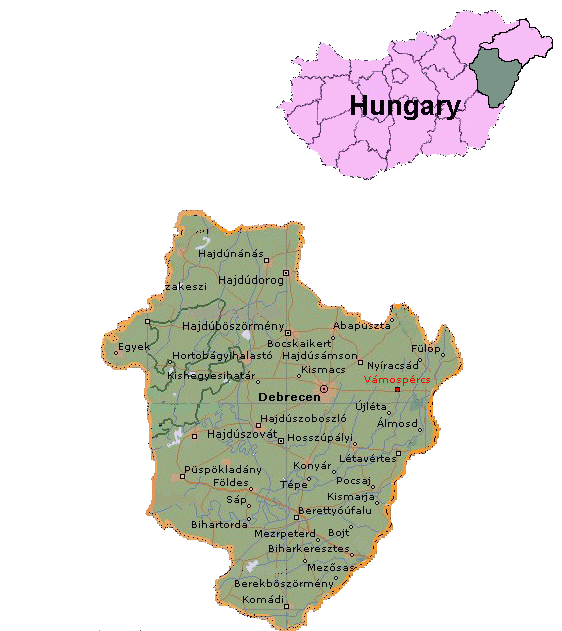|
||||||||
| also known as: Vamosh-pertsh (Yid) 47°32' N / 21°54' E |
||||||||
| ~ Introduction ~ |
||||||||
| ( Click the arrow in the buttons |
||||||||
|
||||||||
| ~ Maps ~ |
||||||||
| Hajdú-Bihar megye, Hungary Map: Copyright ©2009 by Marshall J. KATZ |
||||||||
|---|---|---|---|---|---|---|---|---|
|
||||||||
| NOTE: Clicking a link will open a new page. |
||||||||
|
||||||||
| ~ History ~ |
||||||||
| In 1292-94, Vámospércs was first mentioned in the records of tithes of Nagyvárad by the name of Belperch. In 1992, Vámospércs celebrated the 700th anniversary of its foundation. |
||||||||
| At the end of the 13th century, the king's servants settled here in the middle of a once large oak forest. The word "bel" in the old name originates from this. The landowner had the right to impose duty on the transport of salt and precious metals going through his estate. The village has been called Vámospércs since that time. |
||||||||
| King Matthias gave the village the right to hold fairs and, in 1605, the Hajdú settlements, including Hajdúvámospércs, received the rank of town. The first Calvinist church was constructed at that time. Its first school was constructed in 1742. In 1876, Vámospércs lost its importance and was again considered a village. |
||||||||
| The first Jews were permitted to live here starting about 1850. Jewish settlers were greatly involved in farming in the area surrounding Vámospércs as well as starting the planting of vineyards, which became a very profitable business. |
||||||||
| In 1877, the population of Vámospércs stood at 2,552, comprised of Germans, Slavs, Hungarians, Rusyns and Jews, and organized in the following religions: Roman Catholic (39); Greek Orthodox (44); Reformed (2,303) and Jewish (166).
|
||||||||
| In 1880, the Jewish community maintained a synagogue and grew to a population of 186. A Jewish school was founded towards the end of the century, funded partly by the Hungarians. The shochet (ritual butcher) also served as the dayan (judge). Generally, there were good relations between the Jews and their gentile neighbors until the war years. |
||||||||
| In 1905, the first steam-powered mill was constructed in Vámospércs. |
||||||||
| In the inter-war period, the Jewish population was about 320. |
||||||||
| In 1939, many Jews from the Vámospércs community were seized for forced labor, with many perishing in the Carpathian Mountains. |
||||||||
| In 1941, Vámospércs was still a small village with a Jewish population of 294. Jews were still primarily involved in farming. |
||||||||
| On the second day of Shavuot, 1944 (29 May 1944), the police chief entered the synagogue and announced that all the town's Jews be ready for expulsion the following day. The next day, wagons stood ready to transport the Jews of Vámospércs to Debrecen. Upon arrival, the men were tortured and robbed of their belongings by the Gendarmes and the young men were selected for forced labor. |
||||||||
| During the period 25-28 June 1944, the remaining Jews of Vámospércs were transported from Debrecen to Auschwitz. |
||||||||
| Sources (portions): The Encyclopedia of Jewish Life Before and During the Holocaust, (2001), p. 1374. Yizkor Book for Debrecen |
||||||||
| After the fall of the Iron Curtain, Vámospércs began to develop and it became a town again on 1 July 2001. Today, Vámospércs is a rather large town of 5,477 inhabitants (as of 2001). There is a barber shop constructed on the site of the former synagogue which included the open field to the left, and a Jewish cemetery still remains with approximately 70-80 tombstones. A great number of Vámospércs' Jews were murdered in the Holocaust. After the war, some came back to start afresh, but eventually moved on. Only four Jews live there today (2009). |
||||||||
| This page is hosted at no cost to the public by JewishGen, Inc., a non-profit
corporation. If you feel there is a benefit to you in accessing this site, your JewishGen-erosity is appreciated. |
||||||||
| Created by: Marshall J. KATZ, USA Compiled by: Eugene KATZ, USA with assistance from Bela Miklos GELBER, Canada Bela and Eszter KISS, Romania Ferenc KOLESZAR, Hungary Nevek-Klarsfeld Andrew LENARD, USA Ari TESLER, Belgium Amos Israel ZEZMER, France and the following JewishGen members/descendants and contributors of Vámospércs Jewish families: Eugene KATZ, USA Fran MENG, USA Alex MILLER, USA |
||||||||
| Updated: 23 August 2020 |
||||||||
| Copyright ©2009 Eugene KATZ All rights reserved |
|
||||||||||
| Visitors since: 12 July 2009 |
|---|




